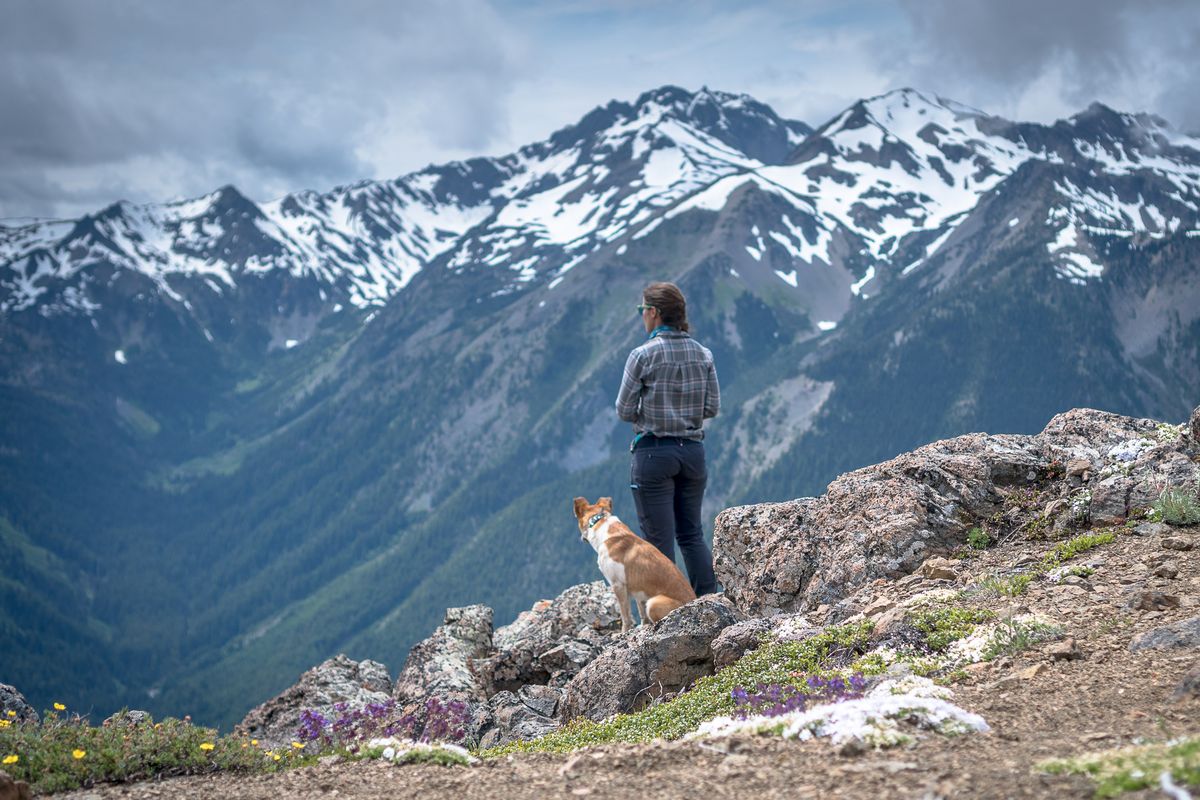Hiking with dogs and learning to speak up, an essential guide

Disaster can arise when you’re an introvert hiking with a reactive dog and you come across one of those “don’t worry, he’s friendly” off-leash dogs.
Jen Sotolongo learned the hard way that she had to speak up for her dog.
“I am the dog owner I am today because of the mistakes I have made with my dogs,” she writes in her new book, ”The Essential Guide to Hiking with Dogs,” part of the Falcon Guides collection.
The book, she said in a phone interview from her home in Portland, is everything she’s learned as a dog owner, a hiker and adventurer.
The content was mostly created over the past 10 years on Long Haul Trekkers, a blog where Sotolongo shares informative articles on how to enjoy the outdoors with your adventure dog.
At the core of Sotolongo’s mission is helping hikers and adventurers be advocates for their dogs and maybe correcting some social dog norms.
“With my first dog, my ex-partner’s dog, Sora, I was totally that person that thought, ‘I love dogs and dogs love me,’ ” Sotolongo said.
Sora didn’t easily accept new people, and she became even more reactive around other dogs. She inspired Sotolongo to learn the art of dog behavior and how our four-legged friends require support from their humans.
“I learned to advocate for her with other dogs and with people,” she said. “Dog owners follow these societal rules about letting their dogs go up to other dogs or people. I don’t know who decided that was OK, but it’s really not great for dogs.
“It can foster behaviors we don’t want, like reactivity or overexcitement, and it made me realize I had to learn to speak up for Sora.”
She’s also had to learn to control herself around other people’s dogs, a hard lesson that came when she met Sora for the first time.
“I thought, ‘Dogs just know I’m going to be nice,’ ” Sotolongo said. “But that’s not how it works. It took a lot of time for Sora to get used to me and accept me.”
Now Sotolongo ignores a dog upon their first meeting, chatting with the owner to demonstrate to the dog she’s OK. She wants others to do the same with her dogs.
The trouble, however, lies in getting new people to understand those boundaries.
“Yes!” Sotolongo said. “It can be so awkward and difficult.
Especially for an introvert.
“I don’t like confrontation. You can sound like a real jerk when you’re asking people not to approach your dog. People don’t like to hear no. They feel like every dog is theirs.”
It took a lot of practice to feel comfortable with speaking up. Sora, who died in 2018 after a recurring battle with cancer, and then Sitka, her 4-year-old heeler mix that she rescued, gave her no choice but to find her voice.
Both adventures with Sora and Sitka – through no fault of their own – landed Sotolongo in situations in which she made mistakes, like falling silent at times when they needed her to speak up.
“When I failed to speak up, I was risking their safety, other people’s safety, my safety,” she said. “I would feel like I let her down.”
Worse yet, she felt like it affected their relationship.
“My dog looks to me for guidance, they need to trust that I will keep them safe,” she said.
“My dogs need to know I have their back.”
Over time, she has narrowed down plans to keep her dogs safe. Expanded upon in Chapter 6, “Hiking with a Reactive Dog,” Sotolongo goes into detail with her intentions to choose low-trafficked trails, to hike at off hours, to muzzle train and to prepare how to handle situations.
She has even practiced the requests she makes of others on hiking trails throughout the Pacific Northwest and beyond.
That preparation has allowed her to be more confident with her voice, she said, because dog owners tend to be sensitive and take some things too personally.
“You can ask people – no matter how kindly – to leash their dogs and they often won’t do anything,” she said. “I choose to say, ‘Would you mind not letting your dog approach?’ and people respond better.”
Of course, most dogs are friendly, whether off leash or on leash. They and their humans, however, don’t always know how that other dog they’re approaching is going to react.
Sotolongo watches Sitka for cues, like his ears pinned back, a tucked or rigid tail, stress yawns or squinty eyes.
As important as the set of procedures, like stepping off trail, she’s developed, she knows the way she reacts is the most important factor in handling the situation.
“I’ve had to learn to tame my anger,” she said. “It just doesn’t help the situation. You can’t be reactive. You have to manage your own emotions.”
The relationship she’s built with her dogs has allowed Sotolongo to do things she might never have . Sora traveled through 30 countries, including a two-year bicycle trip with Sotolongo and her then-partner across Europe and South America.
Sitka is Sotolongo’s trail running and backpacking buddy now.
“Sora was my soulmate, the love of my life,” Sotolongo said. “She was very forgiving of me. Sitka is so sweet. We’ve each had to rely on each other and it has helped build both our confidence.
“Especially because I go hiking solo as a woman. People say, ‘Oh, you hike by yourself; aren’t you scared?’ No, hiking with my reactive dog forces me to be prepared. I always know where I’m going and what to be aware of.”